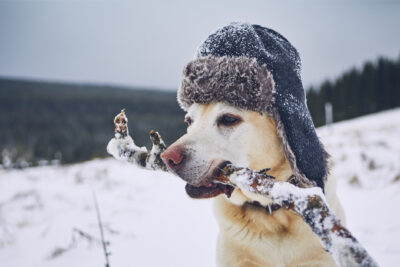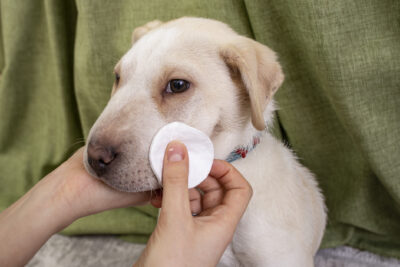9 Toxins That Cause Seizures in Dogs

The Pet Poison Hotline reported a 51 percent increase in calls from 2020 to 2021. This is most likely due to more time spent at home with our pets during the pandemic. Families enjoyed baking, neighborhood walks, and shared food more often in the house which exposed dogs to more substances that are toxic to them. There are even some toxins that cause seizures in dogs.
Witnessing your dog have a seizure can be scary and worrisome. Luckily, seizures in dogs only impact about 5 percent of the canine population. Seizures caused by ingesting a toxin are even less common. However, knowing what household items cause convulsions can minimize your dog’s risk.
Dog Seizures: What Do They Look Like?
Seizures in dogs appear very similar to what a seizure looks like in humans. Dogs can experience loss of consciousness, falling over, paddling of limbs or stiffness of the whole body, excessive drooling, and/or losing control of their bladder and bowels.
Most seizures look very similar, whether they are caused by a toxin ingestion, epilepsy, cancer, or other disease. However, there can be subtle differences, so be sure to note how long the seizure lasted, notable movements (or stiffness) during the episode, and any behavior or activity that preceded the seizure. It is also important to note whether your pup has gotten into the trash, eaten plants, or other household items that could cause seizures.
Toxins That Cause Seizures in Dogs

From foods to household cleaners, there are a variety of everyday items that contain toxins that cause seizures in dogs. Here are the ones you should watch out for:
There are a few foods that are common in households that cause seizures in our companion animals. Chocolate, caffeine, xylitol, ethanol and high salt dough (such as playdough) are some of the most common items.
Chocolate
Chocolate has a substance called theobromine in it that dogs are unable to metabolize, or break down, as easily as humans do. This build up in their system affects their heart and blood vessels, lungs, and their central nervous system which causes seizures. Dark chocolate is much worse than milk chocolate because of the higher concentration of cacao and theobromine.
Caffeine
Caffeine is a stimulant that dogs are very sensitive to, which increases their heart rate, induces cardiac arrhythmias, muscle tremors, and seizures. Caffeine is found in teas, coffee, energy drinks, and other products. Don’t leave your coffee or other caffeinated beverage where your dog can reach it and make sure to keep coffee grounds out of reach of your pup.
Xylitol
Xylitol is tricky because it’s a sugar substitute that can be found in everyday items labeled as “sugar-free.” Xylitol may also be referred to as birch sugar. Be sure to read the labels on chewing gum, mints, peanut butter (or other nut butters), baked goods, or “skinny” ice cream. Xylitol ingestion in dogs causes the release of insulin into their bloodstream. Insulin is responsible for removing sugar from the bloodstream, therefore this results in a rapid decline of blood sugar (hypoglycemia) which causes weakness, incoordination, and seizures.
Alcohol
Alcohol is found in alcoholic drinks, as well as hand sanitizer, antifreeze, raw bread dough, mouth wash, vanilla extract, cosmetics, car coolants, and liquid medications. It is a central nervous system depressant, and signs of vomiting, diarrhea, and visible intoxication usually accompany alcohol toxicity in dogs. More severe signs include seizures and coma.
Homemade Dough
Dough with high salt content, such as homemade Playdough, causes sodium toxicity in dogs. The large increase in sodium causes an imbalance of electrolytes, which regulate muscle contractions, water levels in the body, and nerve impulses. This can damage brain cells and lead to seizures, or even death.
Human Medications
There are both human and animal medications that can cause seizures in dogs. Talk to your vet about any side effects of medications or multiple medications taken together. Some human meds to look out for are: ibuprofen, chemotherapy drugs such as flourouracil cream (5-FU cream), phenylbutazone, or amphetamines. Human medications such as metronidazole and ivermectin are commonly prescribed for animals in safe quantities, but because humans take different doses, might be toxic when ingesting the human dose.
Sago Palms
Sago Palms, especially the seeds, contain multiple toxic compounds, such as cycasin, which is toxic to the liver, resulting in seizures and liver failure in dogs. The first signs you may see are vomiting, diarrhea, and lethargy. Familiarize yourself with these plants and avoid them in your neighborhood.
Amanita Mushrooms
The Amanita species of mushrooms are very poisonous to dogs and cause seizures as well as liver failure, kidney damage, and can be neurotoxic. Be sure to look for these mushrooms growing in your area. Identification of these mushrooms can prevent seizures and further harm to your dog.
Pesticides
Strychnine is used in pesticides that causes tremors, agitation and seizures which can result in respiratory arrest and death. It is extremely toxic to most domesticated and wild animals, and is used in pesticides to control rats, moles, gophers, and coyotes. Bifenthrin is an insecticide that when ingested in larger quantities can lead to tremors, weakness, and seizures. This substance is used against fire ants. Metaldehyde, which is snail and slug bait, can cause seizures and severely elevated body temperatures. The first signs you may see are drooling, panting, weakness, and anxiety.
What to Do if Your Dog Ate a Toxic Substance

If you know your dog ate something toxic, call poison control and bring your dog to the veterinarian right away. Early intervention and care can help prevent irreversible damage or even death.
If your dog is in an active seizure state, try to remain calm and steady, as hard as that may be! Many seizures feel like they last forever, but usually are only about a minute in length.
Make sure your dog is not in danger of hitting their head on hard surfaces or furniture. You can place something soft under their head if they are actively seizing. Do not put your fingers in their mouth, as they can clamp down unknowingly during active seizures. If you can, time the seizure so you can report to your vet how long it lasted. Note how their behavior seemed right before and right after the active seizure.
Call the Pet Poison Helpline and bring your dog to the vet if you suspect that toxicity was the cause of the seizure. If you know what they ate, take a picture of the plant, substance, and bring the packaging and labels if you have it. This will help with determining treatment and care for your dog.
Do not induce vomiting unless specifically told to by your veterinarian, as this can cause aspiration or worsening of signs.
Preventing Toxicity in Dogs
Be sure to identify plants that cause seizures so you can avoid them on walks, hikes, and even in your backyard. Avoid using pesticides, rodenticides, and insecticides that cause harm to dogs and other animals. Be sure to lock up or keep foods, medications, and substances that cause seizures out of reach from your dog. Talk to your family members and guests that come over about not feeding your dog chocolate, coffee, xylitol, and other toxic foods to your dog. Being aware of potentially harmful substances to your dog in your environment can prevent toxin ingestion.









